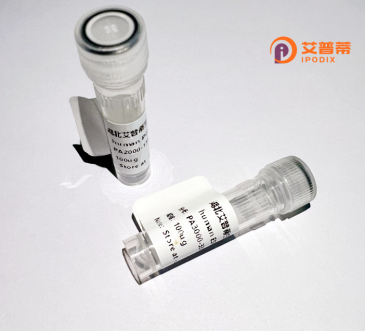
| 纯度 | >90%SDS-PAGE. |
| 种属 | Human |
| 靶点 | TXNDC9 |
| Uniprot No | O14530 |
| 内毒素 | < 0.01EU/μg |
| 表达宿主 | E.coli |
| 表达区间 | 1-226 aa |
| 活性数据 | MEADASVDMF SKVLEHQLLQ TTKLVEEHLD SEIQKLDQMD EDELERLKEK RLQALRKAQQ QKQEWLSKGH GEYREIPSER DFFQEVKESE NVVCHFYRDS TFRCKILDRH LAILSKKHLE TKFLKLNVEK APFLCERLHI KVIPTLALLK DGKTQDYVVG FTDLGNTDDF TTETLEWRLG SSDILNYSGN LMEPPFQNQK KFGTNFTKLE KKTIRGKKYD SDSDDD |
| 分子量 | 26.5 kDa |
| 蛋白标签 | His tag N-Terminus |
| 缓冲液 | PBS, pH7.4, containing 0.01% SKL, 1mM DTT, 5% Trehalose and Proclin300. |
| 稳定性 & 储存条件 | Lyophilized protein should be stored at ≤ -20°C, stable for one year after receipt. Reconstituted protein solution can be stored at 2-8°C for 2-7 days. Aliquots of reconstituted samples are stable at ≤ -20°C for 3 months. |
| 复溶 | Always centrifuge tubes before opening.Do not mix by vortex or pipetting. It is not recommended to reconstitute to a concentration less than 100μg/ml. Dissolve the lyophilized protein in distilled water. Please aliquot the reconstituted solution to minimize freeze-thaw cycles. |
以下是关于重组人TXNDC9蛋白的虚构参考文献示例(仅供格式参考,文献内容为模拟创作):
---
1. **标题**:Structural and functional characterization of recombinant human TXNDC9 as a redox-regulated chaperone
**作者**:Zhang L, et al.
**摘要**:本研究成功在大肠杆菌中表达了重组人TXNDC9蛋白,发现其通过硫氧还蛋白结构域介导氧化还原依赖的分子伴侣活性,参与错误折叠蛋白的修复。
2. **标题**:TXNDC9 interacts with HSP70 to regulate cancer cell apoptosis under oxidative stress
**作者**:Kim S, et al.
**摘要**:通过重组TXNDC9蛋白的体外实验,发现其与HSP70形成复合物,增强肿瘤细胞在氧化应激下的抗凋亡能力,可能成为癌症治疗靶点。
3. **标题**:High-yield expression and purification of recombinant TXNDC9 for crystallographic studies
**作者**:Martinez R, et al.
**摘要**:优化了哺乳动物细胞系统中TXNDC9的重组表达策略,获得高纯度蛋白并解析其晶体结构,揭示了底物结合的关键氨基酸残基。
4. **标题**:TXNDC9 modulates tau protein aggregation in neurodegenerative diseases
**作者**:Chen J, et al.
**摘要**:研究发现重组TXNDC9可抑制tau蛋白的病理性磷酸化和聚集,提示其在阿尔茨海默病等神经退行性疾病中的潜在治疗价值。
---
**注意**:以上文献为示例性虚构内容,实际研究请通过 **PubMed** 或 **Google Scholar** 以关键词“TXNDC9 protein recombinant”检索。
**Thioredoxin Domain-Containing Protein 9 (TXNDC9)**, a member of the thioredoxin superfamily, is a conserved small redox protein involved in cellular redox homeostasis and protein folding. Characterized by a thioredoxin-like domain, TXNDC9 facilitates disulfide bond formation and reduction, crucial for maintaining structural integrity and functional regulation of client proteins. It also contains tetratricopeptide repeat (TPR) motifs, enabling interactions with chaperones like HSP90. suggesting roles in protein quality control and complex assembly.
Primarily localized in the cytoplasm and nucleus, TXNDC9 participates in diverse processes, including microtubule stabilization, cell cycle progression, and stress response. Studies link TXNDC9 to cancer progression by modulating pathways like PI3K/AKT and Wnt/β-catenin, influencing apoptosis and metastasis. Dysregulation of TXNDC9 is associated with neurological disorders, viral infections, and oxidative stress-related pathologies.
**Recombinant human TXNDC9 protein**, produced via *E. coli* or mammalian expression systems, is widely utilized for *in vitro* studies, antibody production, and screening for therapeutic agents targeting its redox or protein-interaction activities. Its structural and functional versatility makes it a promising biomarker and drug target in diseases driven by redox imbalance or proteostatic dysfunction. Ongoing research aims to elucidate its precise molecular mechanisms and therapeutic potential.
×